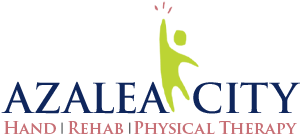Spinal Fusion Physical Therapy/Occupational Therapy in Mobile AL

Spinal fusion is a major surgery that often comes with a long road to recovery. This is where spinal fusion physical therapy/occupational therapy in Mobile AL steps in as a vital component. Without proper physical therapy/occupational therapy, your spine could stiffen, muscles could weaken, and overall mobility could be severely limited. Sounds like a bad deal, right?
At Azalea City Hand and Rehab and Physical Therapy physical therapy/occupational therapy plays a pivotal role by helping you regain strength, mobility, and confidence after surgery. Imagine your spine as a tree with branches - the branches (your muscles) need to be strong enough to support the trunk (your spine). Physical therapy/occupational therapy exercises do just that. They target your core muscles, hips, and legs, which are essential in maintaining spinal alignment.
Not only that, but your therapist will also help reduce scar tissue and inflammation through various techniques like massage or gentle stretching. This helps prevent stiffness and speeds up the healing process. You might be thinking, "I can just rest, and I'll heal eventually." Well, rest is part of it, but active recovery through guided movement can significantly reduce the time it takes to get back on your feet.
Another key reason why physical therapy/occupational therapy is crucial is that it helps you learn how to move safely. Right after surgery, your movements are limited, and it's easy to fall into habits that can cause pain or even re-injury. Your physical therapist will guide you on proper body mechanics and movements to protect your spine and enhance recovery. So, while surgery starts the process, physical therapy/occupational therapy is what helps you complete the journey to full recovery.
What to Expect During Spinal Fusion Physical Therapy/Occupational Therapy In Mobile AL Recovery
After spinal fusion surgery, your physical therapy/occupational therapy journey will begin with a personalized assessment. Your therapist will review your surgery details and understand your current physical condition. Then, they'll create a customized recovery plan.
Expect your early sessions to focus on pain management and gentle mobility exercises. These will gradually build up to more advanced strength training as you heal. You'll learn targeted exercises to improve your core strength, as your core muscles play a critical role in supporting your spine. Your therapist will also guide you on correct posture and movement patterns to avoid putting too much pressure on your spine.
The goal is gradual improvement - you won't be running marathons right away, but step by step, you'll notice progress. Ultimately, you'll regain mobility and get back to the activities you love.
The Best Exercises for Post-Spinal Fusion Rehabilitation
Post-spinal fusion rehabilitation is all about strengthening the muscles that support your spine without putting too much strain on the fusion site. Here are some of the best exercises that are typically recommended during recovery:
- Pelvic Tilts: Lying on your back with knees bent, gently tilt your pelvis upwards, flattening your back against the floor. This helps activate your core muscles without straining your spine.
- Bridging: From the same position as pelvic tilts, lift your hips toward the ceiling while keeping your shoulders and feet on the ground. Hold for a few seconds and gently lower down.
- Heel Slides: Lie on your back and slide one heel towards your buttocks, then extend it back out. This strengthens the muscles in your lower body and improves mobility without stressing your back.
- Wall Squats: Stand with your back against the wall and slowly slide down into a squat, then push back up. This engages your quads and core.
- Stationary Biking: This low-impact cardio exercise helps improve blood flow and build endurance without stressing your back.
Incorporating these exercises into your rehabilitation routine can help strengthen the muscles around your spine and improve your range of motion. Remember, each exercise should be done slowly and carefully, following the guidance of your physical therapist. Over time, these movements will help stabilize your spine, enhance flexibility, and increase your confidence in daily activities.
While it might be tempting to push yourself, recovery after spinal fusion surgery is a marathon, not a sprint. It's important to listen to your body and your therapist's advice to ensure a smooth and steady recovery process.
How Long Does Physical Therapy/Occupational Therapy Last After Spinal Fusion
The duration of physical therapy/occupational therapy after spinal fusion surgery varies from person to person. On average, most patients undergo therapy for about 3 to 6 months. However, the timeline can depend on factors like the complexity of the surgery, your overall health, and how well your body responds to rehabilitation.
In the initial weeks, the focus is on pain management and gentle movement. By the 6-week mark, you'll likely be introduced to more advanced exercises aimed at strengthening your core and back muscles. As your strength and mobility improve, your therapist will gradually increase the intensity of your workouts.
For some, recovery may extend beyond 6 months, especially if there are complications or additional health issues. Consistency is key. Regular sessions will ensure you're on the right track and help you avoid setbacks. Ultimately, the goal is to regain your full range of motion and return to your normal activities without pain or discomfort.
Key Tips for a Successful Spinal Fusion Recovery In Mobile AL
Recovering from spinal fusion surgery requires patience and persistence. To avoid setbacks, it's important to follow these key tips:
- Follow your therapist's guidance: Trust their expertise in pacing your recovery.
- Don't overdo it: Rest is just as important as exercise. Listen to your body and avoid pushing through pain.
- Stick to your home exercise program: In between sessions, continuing your prescribed exercises is crucial to staying on track.
- Maintain good posture: Whether you're sitting, standing, or walking, keeping good posture protects your spine.
- Stay hydrated and eat nutritious meals: Proper hydration and nutrition aid in the healing process.
Following these tips will help ensure a smooth recovery and reduce the risk of complications.
Common Questions About Physical Therapy/Occupational Therapy For Spinal Fusion
Q: What is spinal fusion physical therapy/occupational therapy?
A: Spinal fusion physical therapy/occupational therapy involves exercises and treatments designed to help you recover strength, mobility, and function after spinal fusion surgery.
Q: How soon after spinal fusion surgery should I start physical therapy/occupational therapy?
A: Most patients start physical therapy/occupational therapy 2 to 4 weeks post-surgery, depending on their doctor's recommendations.
Q: Will physical therapy/occupational therapy help with pain management?
A: Yes, physical therapy/occupational therapy can help reduce pain by improving mobility, reducing scar tissue, and preventing stiffness.
Q: How often do I need physical therapy/occupational therapy sessions?
A: Most patients attend therapy 2-3 times a week during the initial stages of recovery.
Q: Can I do physical therapy/occupational therapy exercises at home?
A: Yes, your therapist will give you exercises to do at home in between sessions to support your recovery.
Q: How long will it take to fully recover?
A: Recovery times vary, but most patients recover in 3 to 6 months, depending on the complexity of the surgery and their overall health.
Q: Are there any risks associated with physical therapy/occupational therapy after spinal fusion?
A: Physical therapy/occupational therapy is generally safe, but improper exercises or overexertion can lead to setbacks. Always follow your therapist's guidance.
Q: What happens if I skip physical therapy/occupational therapy sessions?
A: Skipping sessions can delay recovery, lead to muscle weakness, and increase the risk of complications or re-injury.
Q: Will I regain full mobility after physical therapy/occupational therapy?
A: Most patients regain significant mobility, but it depends on the extent of the surgery and individual progress.
Q: Can physical therapy/occupational therapy help me avoid further spinal issues?
A: Yes, strengthening your core muscles and learning proper body mechanics can help prevent future spinal problems.
Spinal Fusion Physical Therapy/Occupational Therapy
Spinal fusion physical therapy/occupational therapy is a crucial part of the recovery process at Azalea City Hand and Rehab and Physical Therapy that helps improve mobility, strength, and overall well-being after surgery. This article outlines key elements such as why physical therapy/occupational therapy is important, what to expect during therapy, the best exercises to promote recovery, and how long the therapy process typically lasts. It also offers valuable tips on how to avoid setbacks by following your therapist's guidance, maintaining good posture, and staying consistent with prescribed exercises.
By combining patience, persistence, and the right rehabilitation approach, patients can regain their full range of motion and return to their normal lives faster. Remember, spinal fusion recovery physical therapy/occupational therapy in Mobile AL is a journey, and each step brings you closer to your goals.
OFFICE HOURS
Monday
8:00am - 5:00pm
Tuesday
8:00am - 5:00pm
Wednesday
8:00am - 5:00pm
Thursday
8:00am - 5:00pm
Friday
8:00am - 12:00pm
Saturday & Sunday
Closed
Azalea City Hand and Rehab and Physical Therapy
316 S Sage Ave Ste C
Mobile, AL 36606


